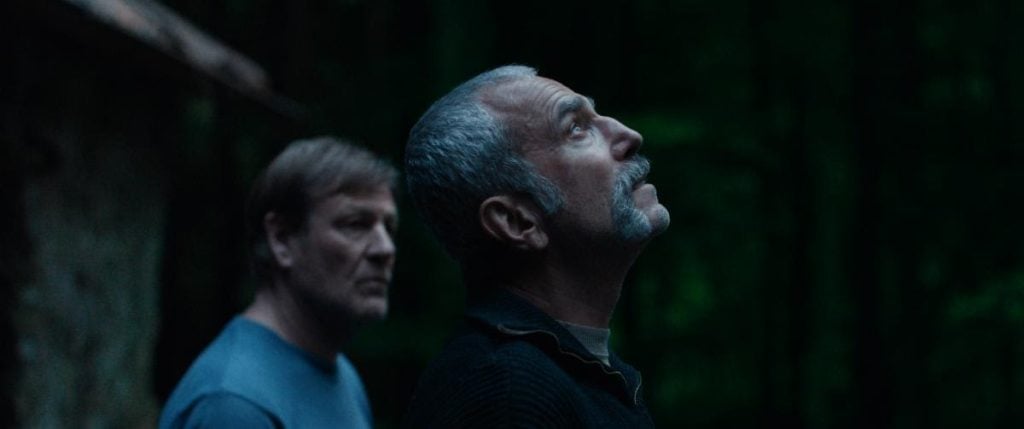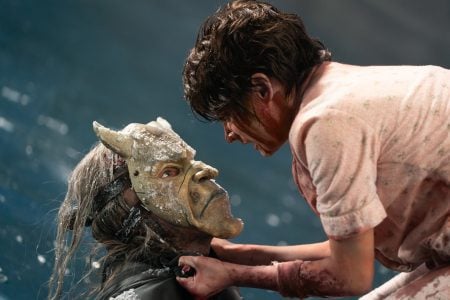The camera is a polyamorous device, but rarely is it a reverent one, a piece of technology that worships more than it adores. Daniel Day-Lewis is this exception’s rule, perhaps its ruler, a subject that lenses fawn over with fascination, yet still treat with something closer to veneration than mere affection. It’s particularly bold, then, that the three-time Academy Award winner’s face isn’t fully visible for the first 20-ish minutes of Anemone, the startlingly bold debut vision from Day-Lewis’ son, Ronan.
World premiering Sunday at the 63rd New York Film Festival, the film’s leading man – widely and correctly regarded as one of the greatest actors to ever live, if not the cream of the crop, full stop – remains concealed for a while, whether the camera is lingering on his back as his character, Ray Stoker, or hiding his mustached mug behind hanging laundry as it flaps in the wind. It’s as if Ronan and his cinematographer, Saint Maud and Love Lies Bleeding DP Ben Fordesman, are waiting for the perfect opportunity to reintroduce us to a man we have been watching command the screen for more than half a century. Day-Lewis, shot like the most formidable performer alive for the entire picture, is a presence unto himself; just showing his daunting, six-foot two-inch frame from behind or the side is enough when we know the face that awaits, whenever it wishes to show itself.
Once it does appear in full, it’s immediately understood why it had been obscured. This Day-Lewis expression – the thespian’s first 2017’s Phantom Thread, after which he “made a fucking fool of [himself]” by announcing his retirement from acting – is quite possibly more tortured than a great many of the many greats he’s conjured in years past, his Ray a hermit who has isolated himself from all of society for decades. His eyes, nose, and pained smirk emerge after his estranged brother, Jem (Sean Bean), arrives at his wooded hut in hopes of reconnecting, or at least reintroducing Ray into his family’s life after a series of shattering events altered the course of their familial bond forever.
The details of Ray’s withdrawal from society remain vague at first, and aren’t necessary to reveal here, but it’s inevitable and clear from the top that he and Jem shared something intimate and complicated as brothers in their youth, carried that into adulthood, and eventually broke away as wounds new and old opened, blood spooling out and salt pouring in. Their friction has plenty to do with Nessa (Samantha Morton), Jem’s wife and Ray’s former paramour; it has even more to do with Brian (Samuel Bottomley), Ray and Nessa’s son, whom Jem now parents as his own. After Brian has an altercation with a young man around his age – late teens or early 20s, it’s safe to assume – that carries severe consequences both physical and psychological, Jem sees it fit to seek out Ray less as a supportive party than as an asset. Warfare, in a variety of sorts, has played a role in the latter’s life; even if he has been present in Brian’s, has he managed to pass down his dark and disturbed sensibilities? And how can they be altered, if not entirely remedied, before it’s too late for another one of the Stoker men?

Anemone’s cards have been kept close to the vest until now; the film’s “synopsis” notes, “The film explores the complex and profound ties that exist between brothers, fathers, and sons.” That’s not much to go on for anyone who hasn’t seen the film (and its vague-enough trailer doesn’t help), but Ronan – who directs alone but co-wrote the script with Daniel – mines a devastating tragedy about broken bonds and the doom they can inspire from what could otherwise have been a trite field of tropes loosely focused on betrayal, abandonment, and the fraying ties that barely manage to bind families together. Of course, it helps that his father is a master of the craft, and it will be difficult not to wonder one: how much Daniel was involved the film’s making, and two: how much of the mysteriousness surrounding its marketing and quick release plan (courtesy of Focus Features, it lands in theaters on Oct. 3, just five days after its premiere) has to do with Daniel’s tendency to remain out of the limelight, delivering dramatically but almost never publicly.
Rest assured, this is far from a dumping tactic; Ronan’s film is just as mysterious, if not inexplicable, as its brief “promotional” run has been and will be in the days leading up to its theatrical release, but in a way that elevates the story at its center through a litany of harrowing, striking sequences and a relentless foreboding nature that creates an air of severity around the whole gamut. Bobby Krlic’s score, best described as orchestral gloom by way of a constantly-blaring electric guitar, has an overwhelming quality to it, and suggestions will be made that this young filmmaker is so reliant on the Midsommar composer’s grim strums that his film never affords its audience an opportunity to catch its breath – or shake its ears out of a state marred by perpetual ringing. Yet Ronan (and Daniel by extension, as the film’s co-scribe) is also savvy enough to know when to let the drama speak for itself.
Anemone could easily be described as merely a well-composed “people talking in rooms” film, but the fact that those people are both so individually and collectively brilliant makes up for what at times renders it a repetitive if visceral experience more than it is a coherent thriller. The “men will literally abandon their families for a stark existence in the Irish wilderness before going to therapy” joke writes itself, but there’s real anguish here, one that Daniel’s Ray shrouds in a brutal defensiveness that only one actor could make tolerable, and that Bean’s Jem fails to emote due to how long it has simmered, only for the boiling point to come when he’s face to face with the one man who can match his long-gestating fury towards the past.

Of course, Day-Lewis is astonishing – lazy comparisons will be made to his work as Daniel Plainview in There Will Be Blood, a masterpiece about a different kind of shitty dad – but there’s something about this part that he had yet to explore in a part before writing one for himself. If anything about the prowess of Anemone as an actor’s showcase comes as a surprise, it’s how fit for the task of going toe-to-toe with cinema’s answer to Shakespeare himself Bean is; a terrific performer in his own right, Jem almost certainly marks a first for the second-best English actor in this ensemble, that of a leading man. Day-Lewis’ name was always going to be the first to appear on the poster, but Bean more than holds his own. For stretches aplenty, Anemone is his movie, and to be so distracted by the prowess of the world-renowned artist to which he stands opposite here that you don’t see the trees Bean is supplying to the forest would be a grave injustice.
So, too, would be reducing Ronan’s achievements here to the presence of his father. The “nepo baby” jab is even easier to realize than the aforementioned quip about Ray’s lack of psychiatric consultation, but his vision with this auspicious first feature is precisely that: Realized, not only in writing, but in the director’s visual dexterity. An artist before he was a proper filmmaker, the prodigal son warrants that weighty distinction on his own, given the triumphant spectacle he’s crafted with Anemone – which, it’s worth noting, takes its title from the flower, not the sea creature. Commonly referred to as “windflowers,” these plants have been previously used to represent forsaken love, the emergence of a breeze, or even dark omens. On the nose? Perhaps. But their significance in the film effectively eschews coming home to roost, instead serving as a visual (and titular) examination of why love is so often forsaken, and why it doesn’t necessarily matter what blood we share when it’s our family that has afflicted us with the most misery. Strong winds may change the seasons, but the past remains. If Anemone has any counterpoint to offer, it’s that the future of one family’s artistic relevance has never been brighter.
Anemone held its World Premiere as part of the Spotlight section at the 2025 New York Film Festival. The film will debut in theaters on October 3, 2025, courtesy of Focus Features.
Director: Ronan Day-Lewis
Writers: Daniel Day-Lewis, Ronan Day-Lewis
Rated: R
Runtime: 125m
If Anemone has any counterpoint to offer, it’s that the future of one family’s artistic relevance has never been brighter.
-
GVN Rating 8
-
User Ratings (0 Votes)
0
Will Bjarnar is a writer, critic, and video editor based in New York City. Originally from Upstate New York, and thus a member of the Greater Western New York Film Critics Association and a long-suffering Buffalo Bills fan, Will first became interested in movies when he discovered IMDb at a young age; with its help, he became a voracious list maker, poster lover, and trailer consumer. He has since turned that passion into a professional pursuit, writing for the film and entertainment sites Next Best Picture, InSession Film, Big Picture Big Sound, Film Inquiry, and, of course, Geek Vibes Nation. He spends the later months of each year editing an annual video countdown of the year’s 25 best films. You can find more of his musings on Letterboxd (willbjarnar) and on X (@bywillbjarnar).






![‘Frankenstein’ Review – Guillermo del Toro’s Definitive Look At The Nature And Nurture Of Monstrosity [TIFF 2025] ‘Frankenstein’ Review – Guillermo del Toro’s Definitive Look At The Nature And Nurture Of Monstrosity [TIFF 2025]](https://cdn.geekvibesnation.com/wp-media-folder-geek-vibes-nation/wp-content/uploads/2025/10/Frankenstein-175_PF_20240430_20377_R-300x200.jpg)